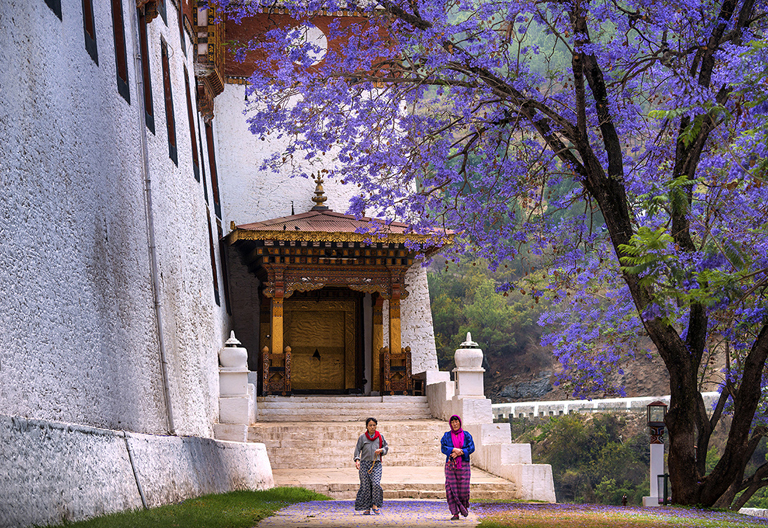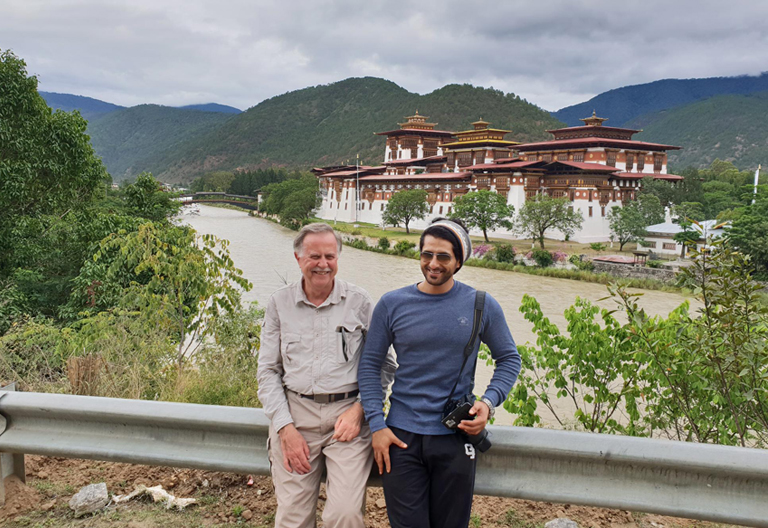Bhutan Tourism Tax - Sustainable Development Fee (SDF)
13 July 2023 Last updated at 16:07
Before starting to plan your Bhutan trip, you should know the tourism policy of Bhutan. The Tourism Council has set up official policies to regulate tourism industry in Bhutan regarding visa, tour, tourism charge, etc.
Bhutan’s Tourism Policy:
1. Bhutan is now open to tourists from all over the world;
2. A Bhutan Visa is required for Bhutan travel. It can only be applied with the help of authorized travel agency;
3. Covid-19 policy: travelers have to provide proof of being vaccinated; PCR test report is not required;
4. Bhutan Tourism Tax, officially known as Sustainable Development Fee (SDF), is 200 USD per night per person. Government has no requirement on the minimum cost of travelers’ daily travel.
Big discounts available for Bhutan's Sustainable Development Fee (SDF) (updated on July 13, 2023):
Bhutan has introduced a fresh initiative to boost extended visits and allow visitors to discover a wider range of experiences in this mysterious country. The newly announced scheme entails a modification to Bhutan's Sustainable Development Fee (SDF). Reservations made starting from June 01, 2023 onwards will be eligible for the exclusive benefits associated with the Sustainable Development Fee (SDF) for guests paying in US Dollars. These incentives are applicable for stays in Bhutan from June 01, 2023 to December 31, 2024.
Based on their planned travel plans, visitors have the flexibility to select from the following options starting from June 01, 2023:
4 + 4: By paying the SDF of USD 200 per person per night for four nights, guests can enjoy an additional four nights without the daily fee.
7 + 7: Guests paying the SDF of USD 200 per person per night for seven nights can receive an extra seven nights without the daily levy.
12 + 18: For a duration of twelve nights, guests can pay the SDF of USD 200 per person per night and receive an impressive eighteen additional nights without the daily levy.
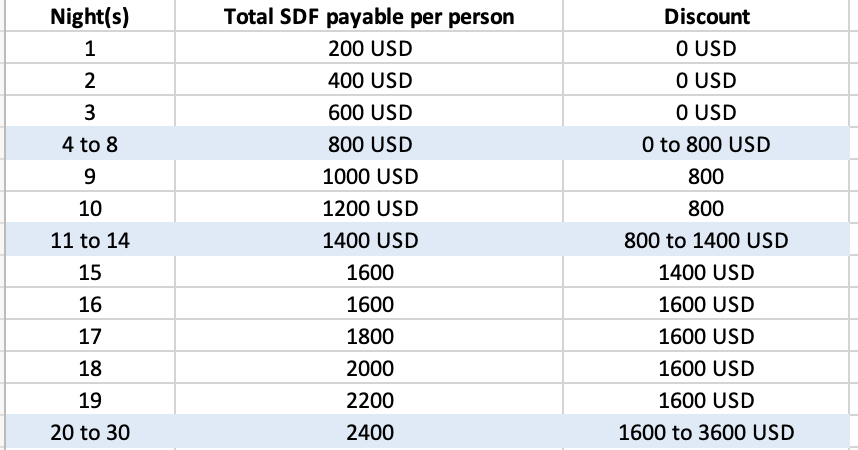
Guests have the freedom to choose the option that suits them best and offers a more cost-effective solution for their journey.
Presently, the SDF stands at $200 per individual per night for all tourists, except for Indian nationals who are subject to a charge of 1,200 Rupees per guest per night. Notably, children aged 5 years and below are exempt from the SDF, while there is a discounted rate of 50% for children between 6 and 12 years old. Individuals aged 12 and above are required to pay the full SDF rate.
Minimum Daily Package Fee Has Been Abolished & Government Tax Increased to 200 USD
Bhutan Tourism Tax, officially known as Sustainable Development Fee (SDF), is increased from 65 USD to 200 USD per night per person. At the same time, the Minimum Daily Package Fee (200~290 USD per person per day including the SDF, accommodation, guide, transportation and meals, etc.) has been abolished, which also means the Bhutan government has no longer requirement on the minimum cost of travelers’ daily travel.
Discounts on SDF: children up to 5 years are exempted from SDF and kids from 6 to 12 years pay only 100 USD per day SDF.
Why the Government Tax Is Increased?
- Explained by Dorji Dhradhul, the Director General of Tourism Council of Bhutan
“The transformation is a return to our root policy of high value, low volume and a renewed commitment to pursue this goal. It will reposition Bhutan as a high value, exclusive destination for discerning tourists. This also translates to raising our standard of infrastructure and service, re-skilling and up-skilling our service providers and providing meaningful and well-paying jobs that ultimately enhance the quality of life of all Bhutanese people.”
2) The SDF Hasn’t Been Increase Since 1991
“The current SDF was implemented since 1991 and has not been increased for the last two decades, and does not reflect inflation, rising purchasing power and growth of tourism pressure on the environment and society. The proposed SDF reflects our position as a high value, exclusive destination defined by the result of carefully crafted policies that have placed sustainability at the forefront. The SDF will address the rising negative externalities such as the carbon footprint of visitors and also uplift the quality of our infrastructure and services. ”
3) Travelers with More Budget Are More Welcomed
“The luxury tourism market is one of the growing segments of the tourism industry, projected to grow to USD 45 billion by 2027 (Global Market Insight). Therefore, we have huge potential to tap into this market, which entails shifts in the customer segment for Bhutan. ”
Most Recommended Bhutan Tours:
☞ 5 Days Bhutan Classic Tour (Paro & Thimphu & Punakha)
☞ 9 Days Bhutan In-depth Natural and Cultural Tour
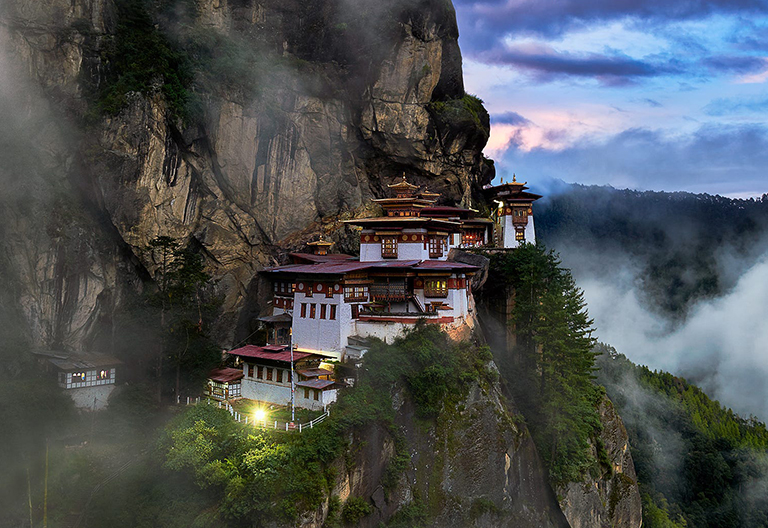
Tiger's Nest Temple in Paro
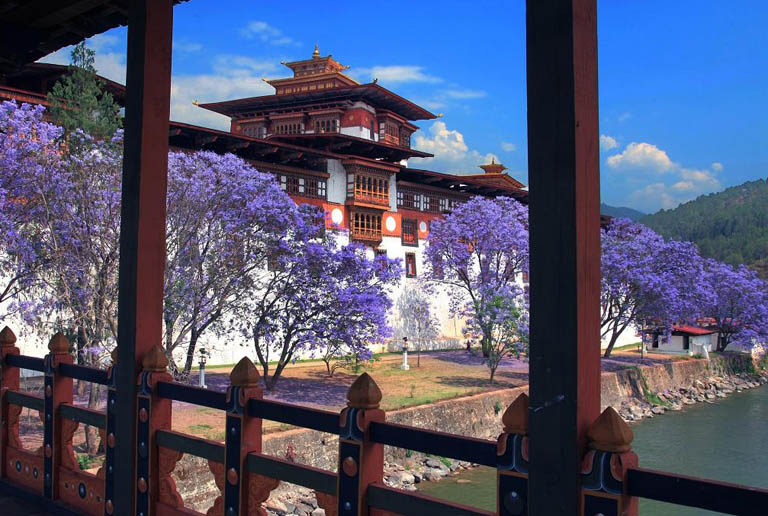
Beautiful Punakha Dzong in April

Meeting local Bhutanese
Independent Travel Is Now Permitted But Not Recommended
According to currently tourism policy, travelers can travel independently in Bhutan with a tour guide. For example, you can book hotels and flights on your own online, then come to Bhutan and travel solo by taxi, bus, etc. But please note Bhutan’s infrastructure is not really ready for this. Travel independently may help you some money, but there are not many places you can reach, and at the same time the quality of your holiday can not be ensured. Most of the treks and adventures in Bhutan also cannot be done without the help of tour operators. Travelers may even miss unique experiences that they even don’t know that exist if they travel independently.
It is also strongly recommended to travel with a travel agency. With a well-arranged itinerary, helpful guide, private transfers, pre-booked fancy hotel, you are able to see and experience more in shorter time. More importantly, flexibility and freedom are provided.
Travel with us, we will work hard on your individual needs and wishes, and make them into the reality as much as we can.
Most Recommended Bhutan Tours:
☞ 5 Days Bhutan Classic Tour (Paro & Thimphu & Punakha)
☞ 9 Days Bhutan In-depth Natural and Cultural Tour

Hospitable Bhutanese Tour Guide

Meals Provided in Bhuan Hotels
Keep Reading about Previous Policy of Bhutan Daily Fee
What is the Daily Fee?
According to tourism policy of Royal Bhutan Government, international tourists (excluding Indian, Maldivian and Bangladesh) have to pay a minimum charge per day per person (eventually charged by night). Official name of this charge is Daily Fee. It covers most of expense of your Bhutan trip, such as tour guide, meals, hotels, etc.
● USD 250 per person per day for the months of March, April, May, September, October and November.
● USD 200 per person per day for the months of January, February, June, July, August and December.
Why the Daily Fee Is Charged?
Bhutan adhere to a sustainable tourist policy which is “High Value, Low Impact”, meaning they want each traveler to enjoy the best possible from the holidays in the county while still preserves the primitiveness of its culture and nature. How to achieve this goal? Set a compulsive charge over tourists.
With a tiny GDP around 2.5 billion in 2019, Bhutan is listed as 164 out of 189 countries in the world in term of global GDP ranking, one of the poorest countries in the world. More than 90% of Bhutanese are farmers. The government tax is levied only from 20% of its population. The rest 80% are not capable of paying government tax. However, the country has so many heritages of culture and nature to preserve, also has to establish tourism facilities, such as airport, road, hotel, etc. to support save and enjoyable travel, at the same time afford free education, healthcare and infrastructure for its people. Also, Bhutan’s government doesn’t want Bhutan become a massive tourist market like Nepal, Thailand and some Southeastern Asian countries whose travel quality have been receded largely due to overdevelopment of tourism. Instead, Bhutan rather keeps a sustainable tourism industry to ensure travel quality for all tourists as well as keep the primitiveness of its culture and nature, by maintaining a very limited numbers of travelers (less than 300,000 annually). The easiest way to do so is by regulation through price.
As a good result, you will not be sharing your holidays with thousands and thousands of other tourists. Even in the most popular sites in its two biggest cities Thimphu and Paro, you will not meet crowds of tourists. This helps to reduce pressures on infrastructure, nature and culture of Bhutan too. It’s important to realize that your travel in Bhutan is not only making contribution to preserve Bhutan’s heritage, but also help improve the living of Bhutanese people.
3 Reasons Bhutan Is Worth the US$250 Daily Fee
1. Bhutan might be one of the few countries that can offer you an entirely authentic experience. It’s a refreshing trip to a beautiful but isolated country where you will not be hassled by annoying tourist groups.
2. You travel with an all-inclusive tour package which covers private tour guide, private driver, fancy hotels, pleasant food, attractions tickets, etc. It’s an absolutely worry-free vacation. If you do the research, you will find it even cheaper than those private tours in developed countries.
3. Your Bhutan tour is making your own contribution to Bhutan and its people, as $65 of $250 is paid to the foundation of Royal Government which is used to preserve the authentic culture and nature of Bhutan, but also help improve the education, healthcare, infrastructure, environment protection, etc.
What’s Covered in the Daily Fee?
1. Private licensed Bhutan local guide from a licensed travel agency who is friendly, helpful and informative;
2. All internal transportation in your tour. Usually, this means a private driver and a comfortable vehicle (4x4 or medium-sized bus, based on your group size);
3. Accommodation of 3-stars hotel which are clean, spacious and cozy for regular tour; Camping for high altitude trekking. Higher standards of hotels may require extra charge; learn more about Bhutan hotels in Paro, Thimphu, Punakha, etc.
4. Meals (breakfasts, lunches and dinners) in your trip and non-alcoholic drinks. Usually provided in your hotel. You can also request to eat at local restaurants;
5. Admission fees for all attractions in your itinerary;
6. Trekking tour (camping gears, chef, porters, etc. )
7. Travel agency service fee;
8. Government tax;
9. USD 65 of Sustainable Development Fee paid directly to the Royal Government of Bhutan as found to help Bhutan’s infrastructure, including country’s education, health care, repairs, and more.
What’s Not Covered in the Daily Fee?
1. Flights to/off Bhutan;
2. Internal flights in Bhutan (fewly used);
3. Bhutan Visa;
4. Personal expense, such as souvenirs, alcohol, cultural shows, etc.
5. Tips for guides and drivers
Surcharges
If you travel solo, or your group has only 2 travellers, you have to pay a surcharge, in addition to the minimum daily fee as following amounts:
Solo tourist: Daily fee+ USD 40 per night
Group of 2 Tourists: Daily fee+ USD 30 per person per night
Discounts
If tourists are eligible for below situations, a discount shall be given:
a) Kids below the age of 5 is free of Daily Fee charge; Kids between the ages of 6~12 years accompanied by adults can enjoy a discount of 50% on Daily Fee;
b) Full time students below the age of 25 holding valid identity cards from their school can enjoy a discount of 25% on Daily Fee;
c) One member in the tourists group with 11~15 people can enjoy a discount of 50% on Daily Fee; 100% discount shall be given to one member of group exceeding 16 tourists;
d) A 50% discount on Sustainable Development Fee after the 8th night, and 100% discount on Sustainable Development Fee after the 14th night shall be given;
e) It shall be free of charge of Sustainable Development Fee on the first/or last night for groups with night halt in Phuntsholing, Sarpang and Samdrup Jongkhar .
Delayed Arrivals and Departures
If your arrival and departure are delayed due to extreme weather conditions or road blocks, you don’t have to pay the Daily Fee, but have to bear the cost of food, hotels, transfers and other services required. You are suggested to buy a travel insurance prior to your tour.
Cancellations
Usually the Daily Fee and other cost of your Bhutan tour can be refunded, depending on the cancellation policies of the tour operators. Fully refund or partly refund usually depends on when your subummit the cancellation request. Check details carefully with your travel agency.
How to Plan Your Bhutan Tour
STEP 1. Choose the best time to visit Bhutan
Lower-altitude area, such as Paro, Thimphu and Punakha, are suitable for travel all year around. However, the best time for most of Bhutan tours, including trekking, photography, etc., is spring (March to June) and autumn (September to October) when the weather is most mild and pleasant. June to August is the rainy season with continuous rainfalls, and better be avoided. If you want a bird-watching tour, you can schefdule your tour in November and December.
STEP 2. Plan your itinerary and book a tour with a Bhutan Travel Agency
Bhutan tours usually range from 4 days to 30 days, depending on the travel style you prefer. Classic Bhutan tours usually start from Paro in the west where Bhutan's only international airport and famous Tiger's Nest are located in, then go eastward to visit the capital Thimphu and beautiful Punakha Dzong, which usually takes about 5~7 days. It is strongly recommended to spend 2 or 3 more days to continue your tour to Phobjikha and Bumtang where the most beautiful valleys and authentic local culture awaiting your exploration. For further in-depth tour, you can go to enjoy a trek or a festival tour. Find recommended Bhutan tours here >
Most Recommended Bhutan Tours:
☞ 5 Days Bhutan Classic Tour (Paro & Thimphu & Punakha)
☞ 9 Days Bhutan In-depth Natural and Cultural Tour
Bhutan is usually visited with its Himalayan neighbor Nepal. We are specialized in providing tailor-made Nepal Bhutan tours of all kinds. Find recommended Nepal Bhutan tours here >
Most Recommended Nepal Bhutan Tours:
☞ 9 Days Nepal Bhutan Highlights Tour
☞ 12 Days Nepal Bhutan Leisure Vacation Tour Package
STEP 3. Take an international flight or drive overland to Bhutan
You can take flight to Bhutan from Nepal, India, Thailand, Singapore and Bangladesh, which reward you with a visual feast of Himalayan peaks from the plane. Among all gateways, Nepal is mostly chosen by travelers. If operate 1 or 2 daily flights to Paro International Airport every day. You could also enter Bhutan overlanding from India. Currently, there are three ports connecting India with Bhutan, namely Phuentsholing, Samdrup Jongkhar and Gelephu in Bhutan. Learn more about how to get to Bhutan >
STEP 4. Prepping and Packing for Bhutan
After confirming your tour, you should start to prepare required travel documents for your Bhutan tour. First, you should have a valid passport. Send the clear and complete photo of your passport to your travel agency; Next, let your travel agency apply for Bhutan Visa for you. A visa clearance letter will be mailed to you. You present the visa clearance letter when checking in the immigration offices of Bhutan, either at Paro Airport or other border ports. The Bhutan Visa will then be stamped on your passport page, and you are all good to enjoy your Bhutan vacation. It usually takes about 7~10 working days to receive the visa clearance after the application request is received by Tourism Council of Bhutan. Learn more about Bhutan Visa >
If you are planning to do some serious trekking, such as Jomolhari Laya-Gasa Trek, Snowman Trek, etc., you should visit your doctor to check your physical condition, sort out any required medications and get up-to-date advice. If your current fitness levels are not strong enough, you should do some training before departure, such as strength exercise, endurance activities, cardio, etc.
The last thing is to start packing. Bhutan has four different seasons. You should pack and dress properly and accordingly. Dress in layers that are easy to put on and off. Warm clothes are necessary for winter travel and high-altitude areas. Also, Bhutan is a religious country. Travelers should wear long pants and long sleeved cloth to show respect when visiting dzongs and monasteries. As for trekking, there is a special packing list >

Taktsang (Tiger's Nest) is a MUST-VISIT
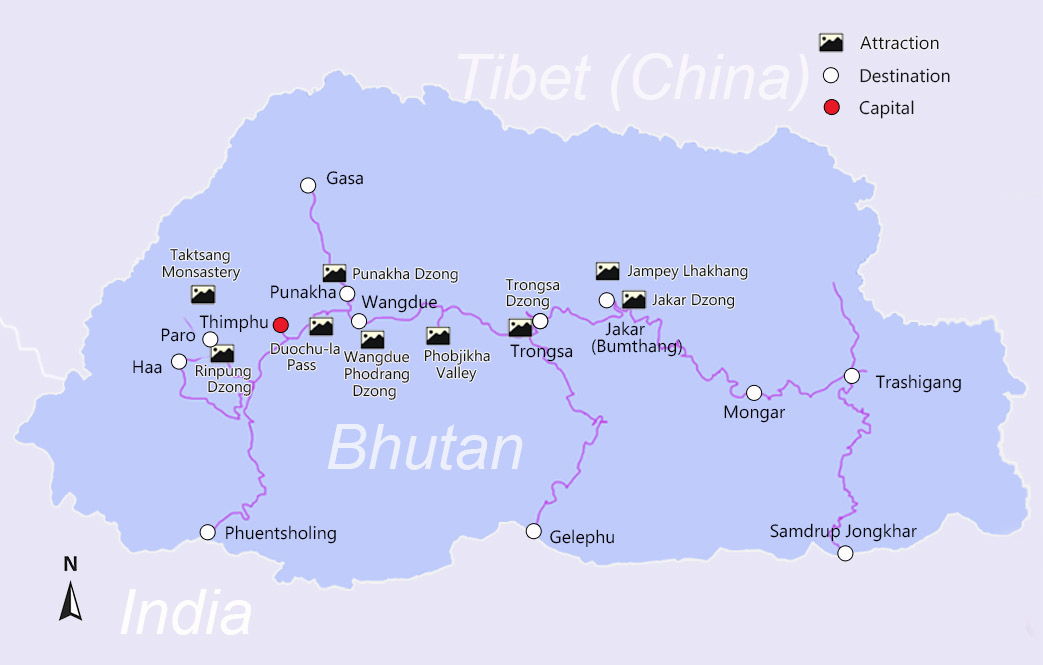
Bhutan Tourist Map


Our guests visiting Bhutan
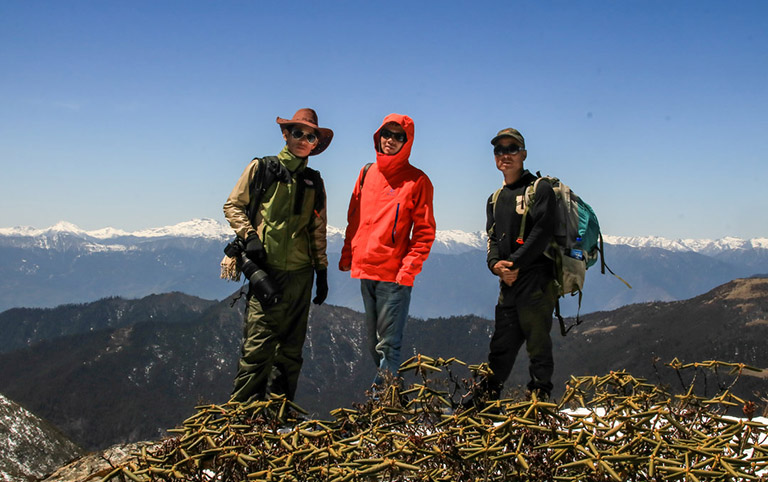
Bhutan Druk Path Trek
Bhutan Travel Guide
Most Recommended Bhutan Tour Packages
Following are 3 most recommended Bhutan tour packages that you may be interested in. All tour packages are customizable to meet your personal requirements. You can also contact us to customize a trip if you want.
-

-

-

9 Days Bhutan In-depth Natural and Cultural Tour
Paro / Thimphu / Punakha / Phobjikha / Trongsa / Bumthang / Wangue Phodrang / Paro

